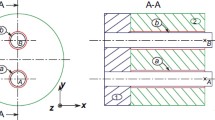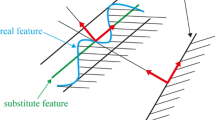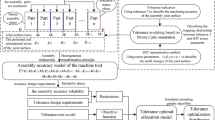Abstract
The safety and performance requirements for mechanisms are such that the necessary accuracy of part geometry is difficult to reach using classical manufacturing processes. This paper proposes a manufacturing tolerance stack-up method based on the analysis line method. This technique enables both the analysis and the synthesis of ISO manufacturing specifications through a new approach which relies on production specifications, adjustment specifications, and their analysis to stack up the 3D resultant. The originality of the method resides in the 3D calculation for location requirements, which takes into account angular effects and probing operations on numerical-control machine-tools in order to define a local work coordinate system (WCS). For achieving tolerance analysis, deviations are modeled using small-displacement torsor. This tolerance analysis method enables one to determine explicit three-dimensional linear relations between manufacturing tolerances and functional requirements. These relations can be used as constraints for tolerance optimization.
Similar content being viewed by others
References
Anselmetti B (2010) CLIC: A method for geometrical specification of products. Geometric Tolerancing of Products. 207–239
Anselmetti B (2010) Manuel de tolérancement (Volume 4) - Cotation de fabrication avec les normes ISO. Hermès Sciences
Anselmetti B (2010) Part optimization and tolerances synthesis. Int J Adv Manuf Technol 48(9–12):1221–1237
Anselmetti B (2012) ISO manufacturing tolerancing: three-dimensional transfer with analysis line method. Int J Adv Manuf Technol 61(9–12):1085–1099
Ballot E, Bourdet P (2001) An integrated framework for 3D tolerance chains in design and manufacturing. In: Proceedings of DETC’01. ASME design engineering technical conferences and computers and information in engineering conference. Pittsburgh, Pennsylvania
Bourdet P (1973) Chaînes de cotes de fabrication. Journal L’ingénieur et le technicien de l’enseignement technique (191)
Bourdet P, Mathieu L, Lartigue C, Ballu A (1996) The concept of the Small Displacement Torsor in metrology. Series on Advances in Mathematics for Applied Sciences 40:110–122
Chase KW, Parkinson AR (1991) A survey of research in the application of tolerance analysis to the design of mechanical assemblies. Res Eng Des 3(1):23–37
Davidson J, Mujezinovic A, Shah J (2002) A new mathematical model for geometric tolerances as applied to round faces. J Mech Des 124(4):609–622
Haghighi P, Mohan P, Shah JJ, Davidson JK (2015) A framework for explicating formal geometrical and dimensional tolerances schema from manufacturing process plans for three-dimensional conformance analysis. ASME J Comput Inf Sci Eng 15(2):021003–021003-13. 10.1115/1.4029555
ISO: 1101:2013 - Geometrical Product Specifications (GPS) - Geometrical tolerancing — Tolerances of form, orientation, location and run-out. International Standard
ISO: 5459:2011 - Geometrical Product Specifications (GPS) - Geometrical tolerancing - Datums and datum systems. International Standard
Kusiak A, Feng CX (1995) Deterministic tolerance synthesis: a comparative study. Comput Aided Des 27 (10):759–768
Laifa M, Sai WB, Hbaieb M (2014) Evaluation of machining process by integrating 3D manufacturing dispersions, functional constraints, and the concept of small displacement torsors. Int J Adv Manuf Technol 71 (5–8):1327–1336
Salomons O, Haalboom F, Poerink HJ, Van Slooten F, Van Houten F, Kals H (1996) A computer aided tolerancing tool II: tolerance analysis. Comput Ind 31(2):175–186
Salomons O, Poerink HJ, Haalboom F, Van Slooten F, Van Houten F, Kals H (1996) A computer aided tolerancing tool I: tolerance specification. Computers in Industry 31(2):161–174
Salomons OW, Van Houten FJ, Kals HJ (1998) Current status of CAT systems Geometric design tolerancing: Theories, standards and applications. Springer, pp 438–452
Vignat F (2005) Contribution à l’élaboration d’un modèle 3D de simulation de fabrication pour l’analyse et la synthèse des tolérances, le modèle MMP. Ph.D. thesis, Grenoble, INPG
Vignat F, Villeneuve F (2007) Simulation of the manufacturing process, generation of a Model of the Manufactured Parts Digital Enterprise Technology. Springer, pp 545–552
Villeneuve F, Vignat F (2007) Simulation of the manufacturing process in a tolerancing point of view: Generic resolution of the positioning problem Models for computer aided tolerancing in design and manufacturing. Springer, pp 179–189
Author information
Authors and Affiliations
Corresponding author
Rights and permissions
About this article
Cite this article
Royer, M., Anselmetti, B. 3D manufacturing tolerancing with probing of a local work coordinate system. Int J Adv Manuf Technol 84, 2151–2165 (2016). https://doi.org/10.1007/s00170-015-7797-4
Received:
Accepted:
Published:
Issue Date:
DOI: https://doi.org/10.1007/s00170-015-7797-4




